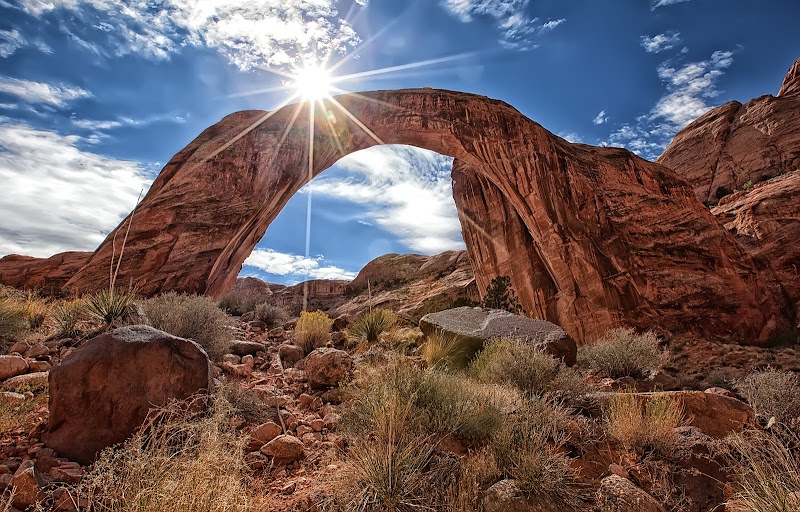
Rainbow Bridge National Monument Adventures
Rainbow Bridge National Monument is home to one of the world's largest natural bridges, offering a wonder of outdoor geology and cultural history.
Popular Activities
Discovering the Majestic Rainbow Bridge: An Adventurous Journey in Utah
Rainbow Bridge National Monument stands as a sublime reminder of the power and artistry of nature, attracting adventurers to its colossal sandstone arch. Towering 290 feet high and stretching 275 feet across, this natural wonder radiates hues of red and orange that shift with the sun’s journey across the vast sky. It’s not just a sight to see; it’s a destination that beckons eager explorers to traverse the rugged trails that lead to its base.
Starting your adventure, you will embark on a scenic drive along Highway 89 that provides breathtaking views of Utah’s diverse landscapes. The anticipation mounts as you turn toward the Rainbow Bridge boat launch at Lake Powell, where your trek really begins. For those who prefer to keep their feet dry, a 2-mile hike from the parking area offers a fantastic alternative—affording you the chance to experience the arid beauty of the desert terrain where sagebrush and cacti flourish against the backdrop of the vibrant blue sky.
The trail to Rainbow Bridge is more than a journey; it's a sensory exploration. As you navigate the path winding through fragrant piñon pines, the earthy scent of damp soil and growing vegetation surrounds you, invigorating your spirit. Listen closely: the murmur of the nearby river is your constant companion, offering a soothing soundtrack that contrasts with the stark beauty of ancient rocks that stand guard along the trail.
As you approach Rainbow Bridge, the anticipation builds. The cliffs seem to close in around you, heightening the thrill of your expedition. You’re not just an observer; you’re a participant in a grand narrative that weaves together the geological and cultural history of this sacred site. Respect the area’s significance by staying on designated trails and observing Leave No Trace principles.
Once you arrive at the base of the bridge, take a moment to absorb its majesty—the light shines through the arch, casting kaleidoscopic shadows on the sunbaked ground. Feel the cool breeze that whispers through the rocks, as if nature is inviting you to rest and reflect. Bring your camera; capturing the spectacle of the bridge against the stark desert landscape is a must. Yet, also allow yourself to simply be present in the moment, embracing the rarity of this natural masterpiece.
To ensure your journey is both safe and enjoyable, plan accordingly. The best months for the hike extend from March to May and September to November, when temperatures are moderate and the trails less crowded. Always carry plenty of water—at least a gallon per person—to stay hydrated in the Utah sun. Comfortable, sturdy footwear is essential, as some sections may be rocky and uneven.
Consider timing your adventure to align with sunrise or sunset for an ethereal experience, as the arch blazes brightly among the colors of dawn or dusk. The quiet moments when fewer visitors trail behind you can make the experience feel even more intimate, as you savor the grandeur enveloping you.
Surrounding the monument, varied wildlife flourishes—keep an eye out for desert bighorn sheep and coyotes, whose presence adds a pulse to this breathtaking landscape. While it’s essential to respect their space, watching these creatures adapt to their environment can deepen your appreciation for the rugged beauty of Utah.
As your hike concludes and you retrace your steps, carry with you not just memories of the arch's majesty but a renewed sense of connection to nature. The journey to Rainbow Bridge isn't merely about the destination; it's a celebration of the adventure that unfolds along the way. Every step, every breath, every glance at the storied rocks—is a reminder of the profound beauty this world holds. Whether you’re an avid hiker or a casual explorer, Rainbow Bridge awaits, eager to share its story with those willing to seek it out.
Plan Your Visit
Everything you need to know to prepare for an unforgettable trip to Rainbow Bridge National Monument.
Entrance Requirements
Fee-free access; permits not required for visits through Lake Powell.
Best Time to Visit
Best visited in spring and fall due to milder weather and cooler temperatures.
Visitor Information
No dedicated visitor center at the monument; nearest facilities are at Glen Canyon NRA.
Getting There
No direct road access; primary access is by boat or extended hiking routes.
Weather & Climate
Summers are extremely hot with temperatures exceeding 100°F, while winters can be cold. Early spring and late fall are the most comfortable for outdoor activities.
Conservation Efforts
Subject to erosion and human impact, ongoing conservation efforts aim to mitigate disturbances around this sacred site while maintaining accessibility.
Camping in Rainbow Bridge National Monument
Find the perfect spot to stay overnight and immerse yourself in the details.
Wahweap Campground
Located near Lake Powell with convenient boat access to Rainbow Bridge.
Lone Rock Beach
Offers beach camping with stunning views and close proximity to launch points for Rainbow Bridge.
Top Trails
Rainbow Bridge North Trail
A remote and rugged trail to the bridge, providing a challenging yet rewarding experience.
Lake Powell Boat Route
Travelers reach the monument by navigating impressive waterways, ideal for scenic photography.
Trailblazer Tips
For the best lighting conditions to photograph the bridge, arrive at sunrise or sunset.
Summer temperatures can be extreme, so plan visits during spring or fall for cooler hikes.
Boating to Rainbow Bridge requires planning due to water levels; check conditions in advance.
A good map and plenty of water are essential for hikes due to the monument's remote location.
